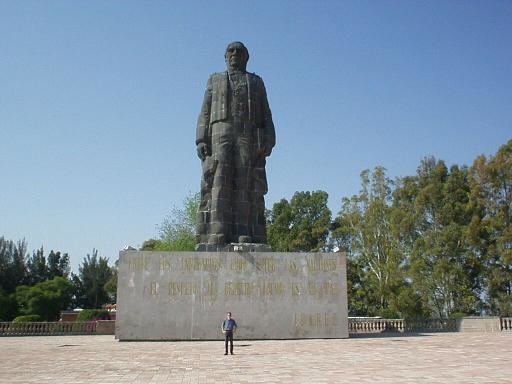 | ||
Address Cerro de las Campanas, Centro Universitario, Santiago de Querétaro, Qro., Mexico Hours Open today · 6AM–6PMWednesday6AM–6PMThursday6AM–6PMFriday6AM–6PMSaturday6AM–6PMSunday6AM–6PMMonday6AM–6PMTuesday6AM–6PM Similar Museo Casa de la Zacatecana, Jardín Zenea, Peña de Bernal, Templo y exconvento de la Cruz, Acueducto de Querétaro | ||
Extranormal cerro de las campanas queretaro
The Cerro de las Campanas (Hill of the Bells) is a hill and national park located in Querétaro City, Mexico. It is most noteworthy as the place where Emperor Maximilian of Habsburg and Generals Miguel Miramón and Tomás Mejía were executed, definitively ending the French intervention in Mexico. The mountain gets its name from rocks that, according to legend, make bell sounds when struck.
Contents
- Extranormal cerro de las campanas queretaro
- Cerro de las campanas
- History
- Maximilian Chapel
- 20th century uses and declaration of a national park
- Museum
- References
Cerro de las campanas
History
The hill on what was formerly the outskirts of Querétaro was the site of the end of the Second Mexican Empire. After being intercepted by the republican generals on May 15, 1867, Maximilian, who had been besieged in the central city of Querétaro since March, surrendered on the mountain to General Mariano Escobedo. He was jailed on the mountain along with his two generals: Miramón, who had been the president of Mexico for most of 1859 and 1860, and Mejía, a Querétaro-born cavalry general. After a court-martial in Querétaro in which all three were sentenced to death, the sentence was carried out atop the hill on June 19, 1867, when Maximilian, Miramón and Mejía were executed.
The site was initially marked with piles of stone topped by crosses made of sticks; later, wooden crosses were placed on the site, which are now housed in the Cerro de las Campanas Museum. In 1886, the first monument was constructed on the site: three stone columns engraved with the names of the deceased, surrounded by iron bars supported by wooden columns, commissioned by Governor Rafael Olvera.
Maximilian Chapel
In 1900, after relations between Mexico and Austria resumed, the Maximilian Chapel (Capilla de Maximiliano) was constructed on the site. Commissioned by Emperor Franz Joseph I in memory of his late brother and designed by architect Maximiliano Mitzel, the chapel was dedicated on April 10, 1901. It is designed in an eclectic Viennese style that "has nothing to do with Mexican buildings". The altar and altarpiece were made at the Querétaro School of Arts and Crafts, and the cross on the altar is taken from the Fragata Novara, the ship on which Maximilian and his wife Carlota arrived in Mexico and which transported his remains back to Austria.
In January 2017, the Querétaro municipal government announced it would invest nearly 1 million pesos for the restoration and maintenance of the chapel. Improvements to be made include cleaning, the installation of LED lighting, and preservation of the entrance door.
20th-century uses and declaration of a national park
In the 1950s, on the west slope of the hill, the Querétaro State Fairgrounds were constructed; the fair would later move to a new site in the early 1970s. On May 15, 1967, the centennial of the arrest of Maximilian, a portion of the mountain, including the east side and the summit, was designated a national park, the same day as the inauguration of a statue of Benito Juárez and a new esplanade by President Gustavo Díaz Ordaz and Governor Manuel González Cosío Díaz; the statue was designed by Francisco de Olaguivel and sculpted by the Rodríguez Granados brothers. The base of the statue features an engraving of a quote by Juárez, Entre los individuos como entre las naciones, el respeto al derecho ajeno es la paz, or "Among individuals as among nations, respect for the right of others is peace".
The southern and western slopes of the hill were transferred in the early 1970s from the fair to the Universidad Autónoma de Querétaro, whose main university campus on the site was dedicated in December 1973.
Museum
The municipal government of Querétaro operates a museum on the mountain, constructed in 2003 and featuring five permanent exhibit rooms. The museum receives some 10,000 visitors each month.
